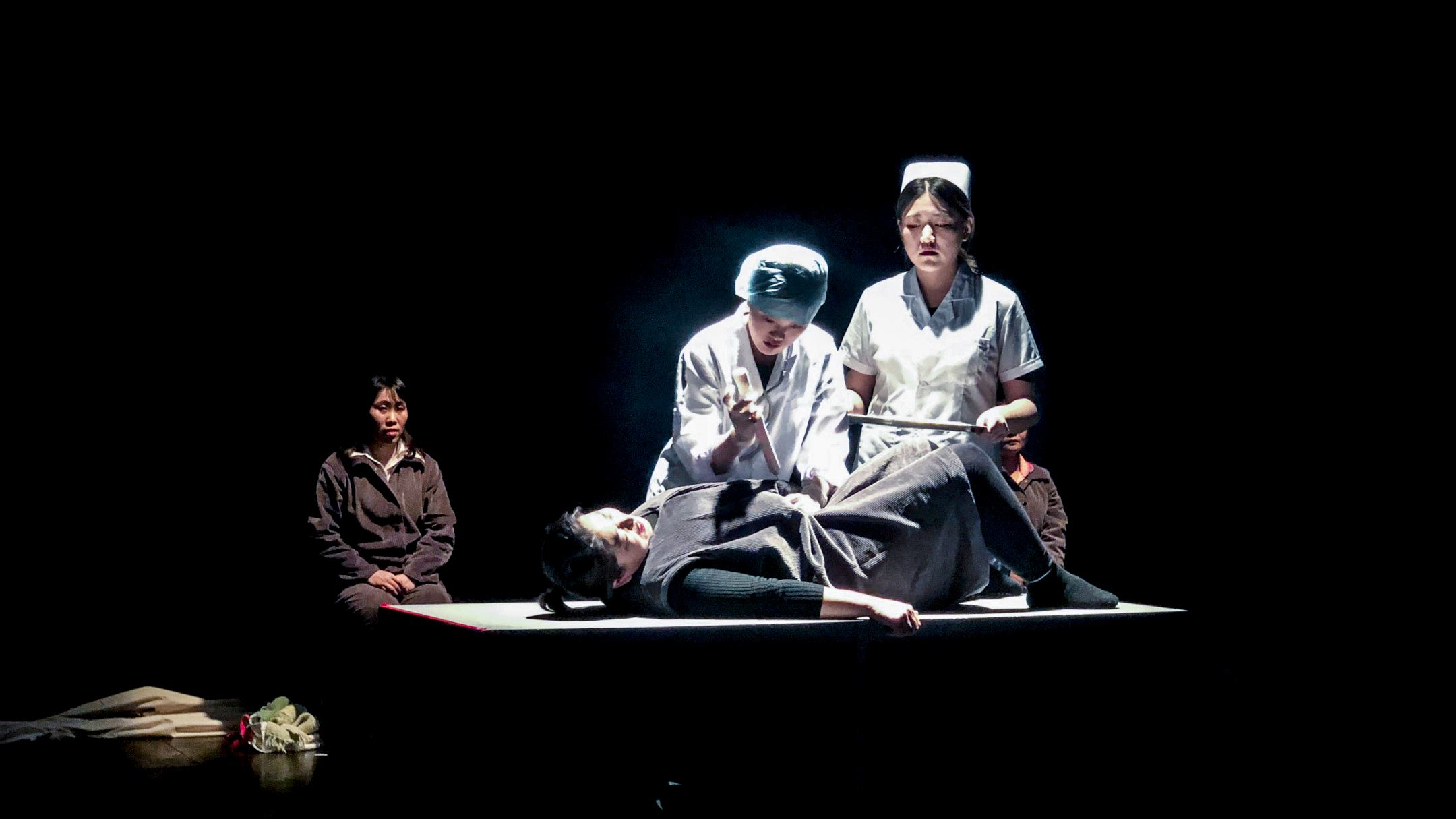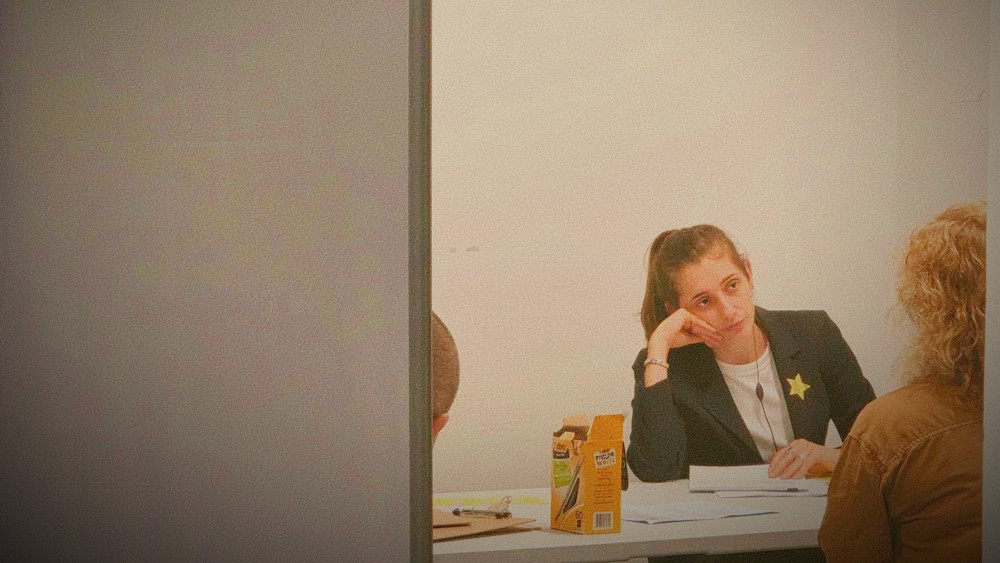Giving Birth, an interview based, devised play co-created by Chinese scholar-artist Zhiyong Zhao and Mulan Community Service Center, centers its storytelling around a group of female migrant workers in Beijing and their authentic accounts of the pain of childbirth. Both a personal and a relatable experience, physical pain becomes an entry point for the downtown Beijing audience to learn about the community of migrant workers, their co-habitants in this metropolis who are often unheard and unseen.
The 2019 premiere of Giving Birth took place in Juyin Theatre, a 100-seat black-box theatre located in the city center of Beijing, a 10-min drive away from Tiananmen Square. On a black hamper lies Liu Yun, a 45-year-old domestic worker and community member of Mulan. She is acting, in character as a woman named Xiaoyu. She splits her legs. An actor playing her doctor touches around on her bulging belly, feels the head of the embryo, and pricks a huge injector into her body. The doctor clips out flesh and bone with pliers and puts them into a plastic bucket. The audience holds their breath, and this tiny space at the heart of Beijing is filled with nervous sounds of ticking clocks, crying babies, and rapid heartbeats.

Over interviews and devising workshops, Giving Birth extracts the real experiences of dozens of community members at Mulan into a single character, Xiaoyu, a young woman from an economically deprived rural province who came to Beijing for job opportunities to support her family. Having no trainings in skilled labor, Xiaoyu becomes a domestic worker in a middle-class household that performs basic cleaning duties on a meagre wage with no legal contract. Due to her early marriage, economical pressure from her family, and lack of proper education in terms of sexual and reproduction health, Xiaoyu undergoes two childbirths and three abortions in five years. Xiaoyu’s story maps out the common dilemmas of underserved working-class women: the crude hygiene conditions, the patriarchal traditional culture in rural society, heavy physical labor and its damage to contraceptive implants, the ensuing unwanted pregnancy, and lack of care and companionship. Unlike the family planning difficulties faced by urban middle-class women, the pain of childbirth experienced by impoverished women is rooted in their social-economic conditions.
Zhiyong Zhao has been a researcher and practitioner of community theatre for over ten years. A popular impression of community theatre regards it as a cathartic channel for collective healing, for relieving repressed trauma through artistic reenactment and expression. However, for Zhiyong, the notion of psychological healing is not only a precarious illusion, but also risks enchanting and concealing the complex conditions of social reality.
The first time Zhiyong showed Liu Yun the script, she said, eyes red, “I can’t finish reading this play—it is too hard for me.” Liu Yun had kept calm and not shed any tears during her interviews, as if she was telling someone else’s story. But when she watched the show at the premiere night, seeing her pain represented on stage, her painful memory was evoked. Liu Yun acknowledged that the process of recreating her story had been painful, but she insisted on bracing herself to speak about it. “I felt I had grown throughout the process,” concludes Liu Yun.
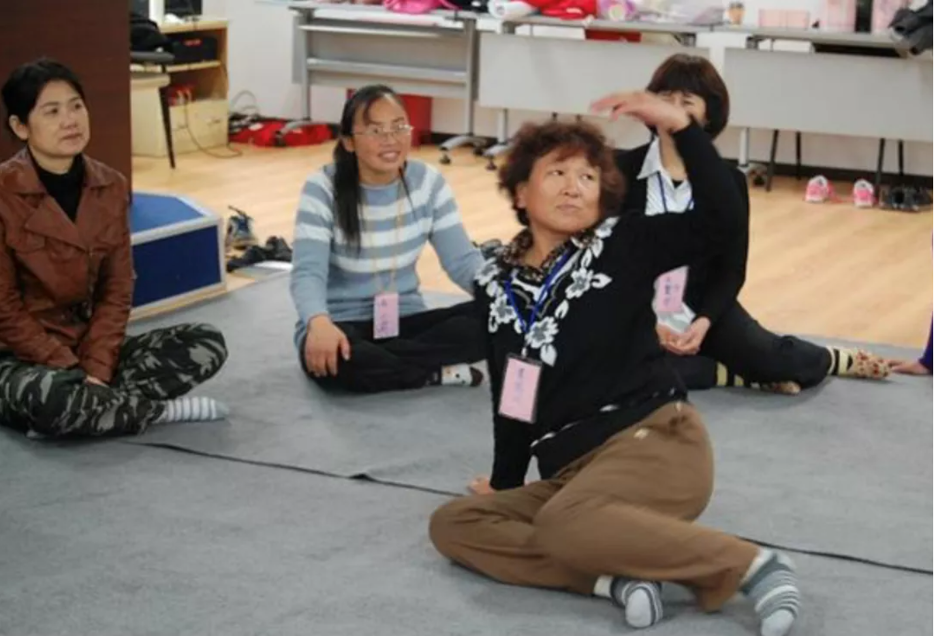
For Zhiyong, the purpose of creating Giving Birth is not the cathartic effect of healing, but to help the society see and understand the difficulties of female migrant workers, which can be anatomized in the subject matter of childbirth. For example, in Xiaoyu’s story, it is carefully demonstrated why the protagonist had unwanted pregnancy time and time again, why she could not afford abortion surgeries in a regular hospital, why she had to go through labor and unlicensed abortions all alone. Despite childbirth being a physical experience, there are many social-economic and cultural factors behind it—and it is this dimension that Zhiyong wants to create a public space of discussion for, rather than shackling these factors within victimized narrative of trauma.
In one scene, a midwife at a rudimentary rural clinic tells Xiaoyu: “It is common to get infection after induced abortion. It’s a part of women’s life. Just apply medication to your private part, no need to let anyone else know and make a scene”—as if abortion is something sneaky and shameful. During Xiaoyu’s postpartum confinement, a village man accuses her of idling all day long to escape working, saying “giving birth is not necessarily painful. It took my wife less time giving birth than it took me harvesting the eggs in the coop”. Xiaoyu’s physical pain is forced into a system of medical as well as patriarchal discourse and disdained as triviality. Giving Birth points out that childbirth is a matter of publicity confined within the field of privacy, and the private nature of physical pain traps the sufferer in desperate isolation and helplessness, with her pain completely subject to distortion and understatement in the public sphere.
Desperately, Xiaoyu can only express the pain of labor, infection, sting, and laceration in the most spontaneous way on stage—groaning, crying, wringing, and shouting. Ironically, confronted by this violent yet powerful display of body language, any other form of dismissive discourse appears dwarfed. By employing the most natural expression of pain, Xiaoyu has restored her right to her own body and memory at a heavy price. The pain, as an unruly force, restores the body’s own biological sensations and expressions. In other words, as Xiaoyu feels and expresses her pain, her aching uterus is no longer the sacred palace for birth, her vagina no longer passage to life, breasts no longer sweet source for growth. Rather these have become rebellious organs, escaping from the strict patriarchal discipline for body.
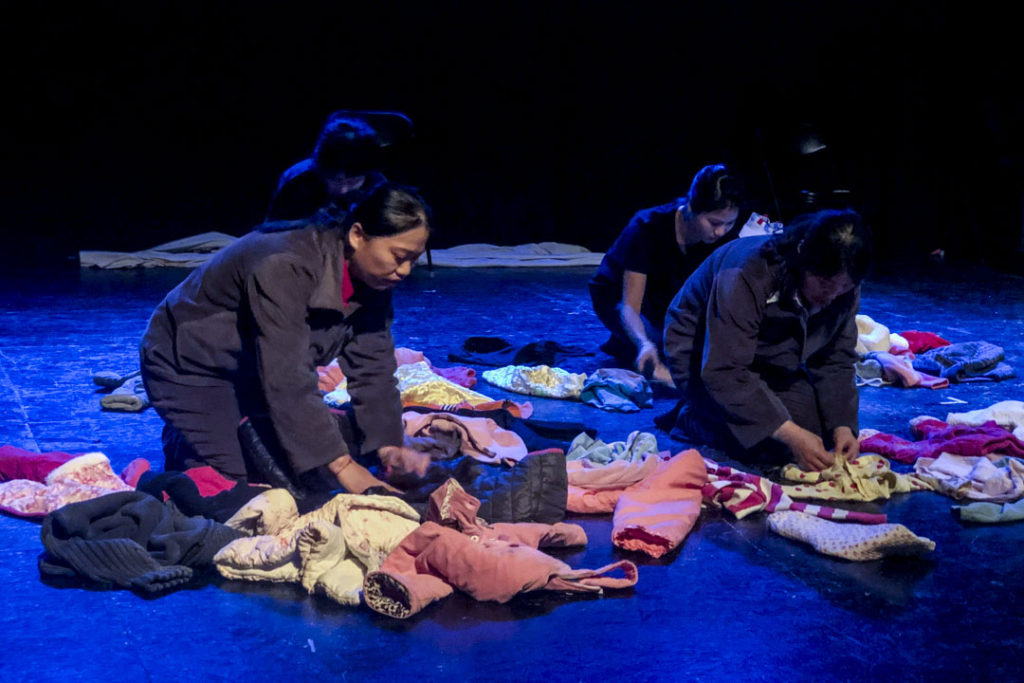
Not only did the workers at Mulan generate the content of Xiaoyu’s story from their own experience, they also delivered it on stage as an ensemble. Giving Birth exemplifies a private experience by having one interviewee and three monologists (all are migrant female workers at Mu Lan Hua Kai) telling and embodying Xiaoyu’s story together. When Xiaoyu goes through abortion operation and childbirth, the monologists simultaneously act out her pain in gestures, facial expressions, and body movements.
The ensemble of worker-actors forms on stage a powerful epitome of millions of working-class women in China. Through their ensemble performance, pain of childbirth becomes sharable and discussable, thus bonding females into a close sisterhood of solidarity. Individuals seize back the sovereignty of their body by openly discussing their stigmatized pain, and by sharing this pain they have transformed their bodies in pain into a public space open for release, comfort, and understanding.
Beyond the bodily and gendered experience, the most touching and thought-provoking aspect of Giving Birth is its deep and truthful investigation in the intersectionality of female workers’ hardship. When we talk about women’s solidarity in a feminist context, one of the most challenging problems is the fragmentation of different groups within women—the fractioned landscape of feminist discourse awaits to be integrated. Giving Birth is not a radical feminist manifesto, or a simplified chastisement against men, but an attempt to build a bridge of understanding between men and women, between urban middle-class audience and rural working-class creators/performers—between different groups of people who are isolated in rigidified social positions, to see each other’s real life.
Zhiyong remarks, “theatre has the potential to transform itself into a cultural practice and public action in a broader social arena.” Including Giving Birth, he has been directing and participating in several long-term projects with Mulan Community. Over years, Zhiyong and workers like Liu Yun get to know each other, support each other, and establish a very deep emotional bond. It becomes a companionship.
He is not unaware of a common and fairly solid argument against methodologies of community theatre: when the logic of art industry attributes ownership and credits of collective process to artists, it is unavoidable that ordinary “civilians” are being used and exploited by artists. In Zhiyong’s opinion, artists’ work today has largely become a matter of using their expertise to build a platform for public participation. The mode of art production has undergone such a profound transformation that if the finalized artwork is still signed by the artist’s name and exhibited in galleries and museums, or performed in art festivals, then there is a logical as well as ethical paradox. The task of community theatre is to suture the world of arts with the world of reality, and transform theatre into a space where we think, criticize, and make change, instead of a magic box to re-enchant the relations between people and their reality.
In July 2020, Giving Birth presented its last showing online, streaming a recording of their 2019 live performance. As it reached a larger audience home and abroad, many of the cast members had already left Beijing and their community at Mulan, due to the heavy impact of the COVID-19 on domestic jobs such as housekeeping and cleaning. Now, the only on-going project at Mu Lan Hua Kai is an online photography workshop: Zhiyong has invited a photographer to provide free vlog tutorials of cell-phone-photography in a WeChat group, where community members are encouraged to take pictures of their everyday lives, share thoughts, and discuss.
It has been months since Zhiyong has been able to see any of his community “sisters” in person—but he would check out their photographs in the WeChat group from time to time, and get to know everyone’s experiences and feelings over the past few months. Zhiyong says, “This is really a great way to maintain a community, to give our sisters a sense of belonging and power of creation, and most importantly, just to have fun despite the hardship of life. This is a way for art to enter and engage in people’s lives that I truly appreciate.”
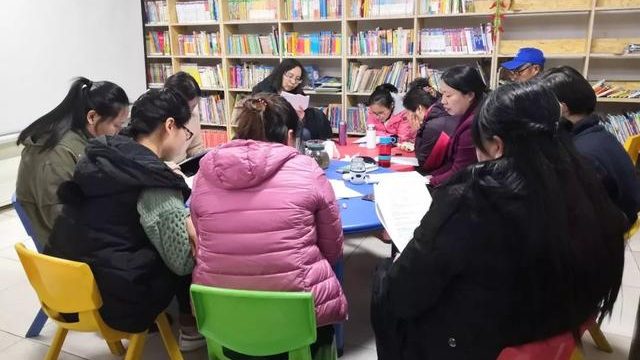
Author
-

Siting Yang (she/her) is an interdisciplinary theater maker based in Beijing and NYC. Her body of work is motivated by a twofold impulse: revolution and nostalgia. By revolution, she seeks to explore radical aesthetical expressions of individual discontent, resistance, and digression in the oppressive system of everyday life. By nostalgia, she collects stories from the trajectory of history and literature that resonate with our modern souls, and reshape them with contemporary relevance. Her recent credits include: HoD (New York, 2021), The Tin Drum (Toronto, 2021), War Eagle (Beijing, 2019), Marat/Sade (Beijing, 2018). She received her B. A. at Peking University in German Literature and World History, and is currently pursuing her MFA in dramaturgy at Columbia University.
View all posts


